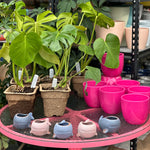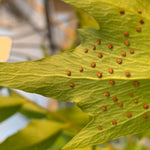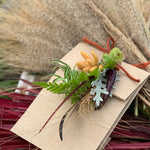There comes a turning point in summer where a particularly "felt" shift settles into the air, and suddenly we are aware: fall is coming. Fortunately, nature has a kind way of letting us know, and then returning with some gorgeous summer conditions; but, ultimately, the reminder that change is ahead can help us plan and take advantage of the transition.
For zone 3 gardeners heading into the last week of August, two interesting opportunities occur. The first is the potential for growing your best leafy greens of the entire season. The second is the opportunity to plan for and prep valued plants that you want to winter indoors, but do so under ideal conditions.
Maggie - from the Grow Guide podcast - harvesting spinach from her raised beds When it comes to sowing a late summer/fall crop of leafy greens, there are several distinct advantages supported by current conditions. First, plants grow and establish relatively quickly, with the combination of warm soil and ideal air temperatures. In spring, the soil is cold and air temperatures quickly jump to hot (conditions which can slow down germination, and also cause leafy greens to immediately bolt) while pre-fall conditions are typically moderate and comfortable, trending towards perfectly cool. A huge number of leafy veggies produce their tastiest bounty in late summer/early fall. Second, garden space opens up in late summer, as crops such as potatoes, peas, garlic and other earlier-harvested veggies finish up... so, easy opportunity to replant these areas and keep the garden producing into October (for real). Third, pest pressures are often at their lowest as we head into fall, particularly for bugs such as aphids, flea beetles, and cabbage moths - all of which can be hard on leafy greens sown earlier in the year.
When it comes to sowing a late summer/fall crop of leafy greens, there are several distinct advantages supported by current conditions. First, plants grow and establish relatively quickly, with the combination of warm soil and ideal air temperatures. In spring, the soil is cold and air temperatures quickly jump to hot (conditions which can slow down germination, and also cause leafy greens to immediately bolt) while pre-fall conditions are typically moderate and comfortable, trending towards perfectly cool. A huge number of leafy veggies produce their tastiest bounty in late summer/early fall. Second, garden space opens up in late summer, as crops such as potatoes, peas, garlic and other earlier-harvested veggies finish up... so, easy opportunity to replant these areas and keep the garden producing into October (for real). Third, pest pressures are often at their lowest as we head into fall, particularly for bugs such as aphids, flea beetles, and cabbage moths - all of which can be hard on leafy greens sown earlier in the year.
Cilantro and leafy lettuces happily growing outdoors in early October The actual planting of late season leafy crops couldn't be easier. The main goal is to get the greens established quickly, so be sure to plant by around Labour Day, otherwise the decreasing day length will start to slow growth. In our climate, all of the fall crops are best direct sown versus started in cell trays or pots indoors; so, literally, prep your beds or large pots and simply scatter the seeds (and then water)!
The actual planting of late season leafy crops couldn't be easier. The main goal is to get the greens established quickly, so be sure to plant by around Labour Day, otherwise the decreasing day length will start to slow growth. In our climate, all of the fall crops are best direct sown versus started in cell trays or pots indoors; so, literally, prep your beds or large pots and simply scatter the seeds (and then water)!
The top zone 3 picks for leafy veggies and herbs to plant in late August include: arugula, beets (particularly for tops), calendula, chard, cilantro, collards, leafy celery, chervil, kale, leafy lettuces, lettuce blends, mesclun mixes, mizuna, bunching onions, and fall radishes (different from spring radishes). If you need seeds, click here for all in-stock varieties available right now at the shop, or for mailing out.
Lemon Verbena and many other higher zone plants are so worth wintering indoors! As mentioned, the second big topic of late August is organizing for plants that will be moving indoors for winter. This one always stings a little, as it it feels early to be worrying about plants coming inside. However, in zone 3, the transition can be quite abrupt and difficult for plants if left to later fall - so preparing now will increase success/decrease stress significantly.
As mentioned, the second big topic of late August is organizing for plants that will be moving indoors for winter. This one always stings a little, as it it feels early to be worrying about plants coming inside. However, in zone 3, the transition can be quite abrupt and difficult for plants if left to later fall - so preparing now will increase success/decrease stress significantly.
I love growing a wide range of Mediterranean, subtropical and a few tropical herbs and fruiting plants, and I know many cold climate gardeners also enjoy a variety of ornamental species that are regional to higher zones. These are the types of plants that can be wintered indoors, while annuals and lower zone (hardy) plants are fussy or frustrating to keep going indoors. So, start by identifying the zones of any plants you are wanting to winter and then thinking about what winter conditions are like for these plants in their local climates (temperature, light, humidity). This is important, as mid-zone plants like rosemary or geraniums have much different winter preferences compared to a tropical plant like a black pepper vine. Think ahead to where you are going to grow various types of plants indoors; just as in the outdoor garden, the principle of "right plant for right place" very much facilitates success indoors.
Root pruning and repotting are often a missed opportunity in late summer After determining where your various plants will end up indoors, check if anything needs repotting or root pruning. Taking care of this now will allow your plants to settle into new pots or soil for a few weeks before moving indoors, so again, one less stress for your plants once inside (the goal is to make the transition as least stressful as possible, remembering that indoor conditions in general are very different from outdoors in summer).
After determining where your various plants will end up indoors, check if anything needs repotting or root pruning. Taking care of this now will allow your plants to settle into new pots or soil for a few weeks before moving indoors, so again, one less stress for your plants once inside (the goal is to make the transition as least stressful as possible, remembering that indoor conditions in general are very different from outdoors in summer).
Lastly, mark on your calendar "move plants indoors" for sometime in the first two weeks of September (or earlier if night temperatures start to really fall off). This is super important, as it is too easy to see plants looking happy outdoors well into fall and then leave them outside. In fact, they are going to be much more challenged if they move after experiencing even a couple of weeks of cool over nights. So, a calendar reminder is a big help when our brains say, "I'll leave them outside for now".
There are additional steps for success with bringing plants indoors - but I'll cover these closer to the actual "move date". What is important right now is the above planning.
Hope this discussion on late summer sowing and planning for the move indoors helps you get the most out of your 2025 garden! Feel free to drop by Sage Garden if you have questions, we are here to help.







